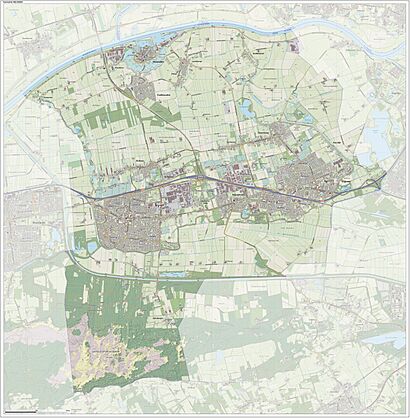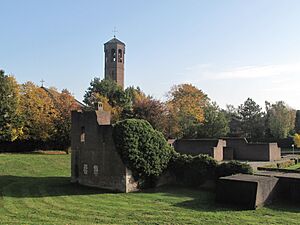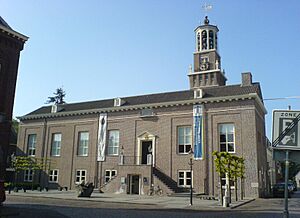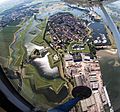Heusden facts for kids
Quick facts for kids
Heusden
|
|||
|---|---|---|---|
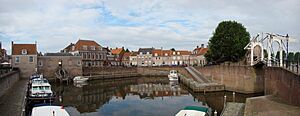
Old harbour in Heusden
|
|||
|
|||

Location in North Brabant
|
|||
| Country | Netherlands | ||
| Province | North Brabant | ||
| Government | |||
| • Body | Municipal council | ||
| Area | |||
| • Total | 81.22 km2 (31.36 sq mi) | ||
| • Land | 78.87 km2 (30.45 sq mi) | ||
| • Water | 2.35 km2 (0.91 sq mi) | ||
| Elevation | 4 m (13 ft) | ||
| Population
(May 2014)
|
|||
| • Total | 43,199 | ||
| • Density | 548/km2 (1,420/sq mi) | ||
| Time zone | UTC+1 (CET) | ||
| • Summer (DST) | UTC+2 (CEST) | ||
| Postcode |
5150–5154, 5250–5256
|
||
| Area code | 0416, 073 | ||
Heusden is a cool city and a "municipality" (which is like a group of towns working together) in the southern part of the Netherlands. It's located between the towns of Waalwijk and 's-Hertogenbosch. In 1997, several smaller towns like Herpt, Heesbeen, Hedikhuizen, Doeveren, and Oudheusden joined with Drunen and Vlijmen to form the municipality it is today.
A big part of the Loonse en Drunense Duinen national park is also found within the municipality of Heusden.
Contents
Towns and Villages in Heusden
The municipality of Heusden includes several smaller towns and villages. These places all work together under one local government. Here are some of the main ones:
- Doeveren
- Drunen
- Elshout
- Giersbergen
- Haarsteeg
- Hedikhuizen
- Heesbeen
- Herpt
- Heusden
- Nieuwkuijk
- Oudheusden
- Vlijmen
Heusden City History
Heusden itself is a very old city with a rich history. Before 1997, it was its own separate municipality.
Heusden Castle: A Stronghold's Story
The city of Heusden started to grow around Heusden Castle. This castle was built after an older one was destroyed in 1202 by the ruler of Brabant. The new castle quickly grew with water defenses and a tall main tower called a donjon.
Heusden was given "city rights" in 1318. This meant it had special permission to be a city. The castle belonged to the rulers of Brabant for a while. Then, in 1357, it became part of Holland. Strong walls called ramparts and ditches filled with water, known as moats, were built around the city. This made the castle part of the city's defenses, so it wasn't needed as a separate stronghold anymore. The donjon then became a place to store weapons and explosives.
On July 24, 1680, a huge thunderstorm hit Heusden. Lightning struck the donjon, causing a massive explosion. Sixty thousand pounds of gunpowder and other ammunition blew up, destroying the castle. It took seven weeks to clear all the mess. The castle was never fully rebuilt. However, in 1987, the basic shape of the castle was restored so people could see where it once stood.
City Defenses and Restoration
At the start of the Eighty Years' War (1568–1648), Spanish forces took over Heusden. But in 1577, the people of Heusden joined forces with William, Prince of Orange, to fight for their freedom. William understood how important Heusden's location was near the Meuse River. He ordered new defenses to be built.
Work began in 1579. Workers dug moats and built strong walls, bastions, and ravelins (triangular defenses). These defenses were finished by 1597, making Heusden a very strong fortress.
By the early 1800s, these defenses were old and falling apart, so they were taken down. But in 1968, a big project started to rebuild them. The restoration was based on a detailed map of Heusden from 1649 by Johannes Blaeu. In 1980, Heusden won a special European award for its restoration work. Today, over 350,000 tourists visit Heusden each year to see its historic center and walk on the walls that once protected it.
The Heusden Town Hall Tragedy
In October 1944, near the end of World War II, the nearby cities of Tilburg and 's-Hertogenbosch were freed by the Allied forces. Heusden was still occupied by German soldiers, and its bridge over the Meuse River made it a very important location.
The old town hall, built in 1588, had cellars that people used as shelters during artillery attacks. The German army also used the building as a communication center and a hospital.
On October 20, 1944, the Allied "Operation Pheasant" began. British and Canadian armies fought to free central and western North Brabant. On Saturday, November 4, 1944, during heavy fighting, two Scottish regiments advanced. About 170 civilians went into the town hall cellars for safety.
In the early morning of November 5, German army engineers blew up explosive charges they had placed in the 40-meter tower. The tower collapsed, killing 134 people. Heusden was devastated. One-tenth of the town's population died that night in the town hall cellars. More than half of the victims, 74 people, were children aged 16 or younger. Just hours later, a Scottish battalion freed Heusden.
People who saw what happened said that on November 4, German soldiers put explosives in the town hall tower. They also put them in two churches, a windmill, and a dairy factory in Heusden. An officer named Bottnick, likely following orders, made sure the tower would fall onto the town hall, not into the street. British investigators looked into these events later, but no one was ever punished for what happened.
A new town hall was built in 1956. It's much simpler than the old one. A memorial stone outside still remembers the lives lost that night. It says: "Passer-by, where you are, on five November 1944 one hundred and thirty four civilians fell victim to the war.". Inside the building, there are also inscriptions on a bell and an epitaph remembering the victims.
The "Stadhuisramp" (Town Hall Disaster) is remembered every year. After the municipalities merged in 1997, the town hall was no longer used for government meetings. Since 2005, the building has been a visitors' center.
Famous People from Heusden
Many interesting people have come from Heusden and the surrounding areas. Here are a few:
- Gisbertus Voetius (1589 in Heusden – 1676) a Dutch religious scholar.
- Jonkheer Jacob van Eyck (around 1590 in Heusden – 1657) a Dutch nobleman, musician, and composer.
- Dirck van Delen (around 1605 in Heusden – 1671) a Dutch painter known for palaces and church interiors.
- Jacob van Wassenaer Obdam (1645 in Heusden – 1714) a Dutch general during the War of the Spanish Succession.
- Hendrik Merkus de Kock (1779 in Heusden – 1845) a Dutch general and important figure in the Dutch East Indies.
- Theodore James Ryken (1797 in Heusden – 1871) a Dutch Roman Catholic who started the Xaverian Brothers.
- Josje Huisman (born 1986 in Heusden) a Dutch singer, actress, dancer, host, and writer.
- Jolijn van de Wiel (born 1992 in Drunen) a Dutch actress.
Sport Stars
- Ton van Engelen (born 1950 in Den Bosch) a retired Dutch football goalkeeper.
- Lars Boom (born 1985 in Vlijmen) a professional cyclist who competes in cyclo-cross and road racing.
- Jesse Timmermans (born 1989 in Vlijmen) a Dutch tennis player.
Images for kids
See also
 In Spanish: Heusden para niños
In Spanish: Heusden para niños




